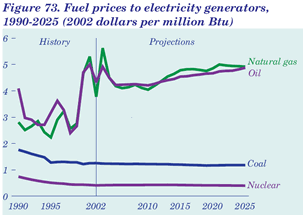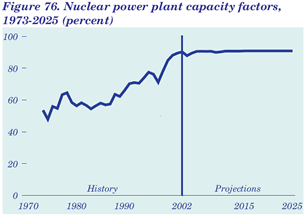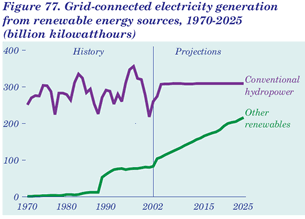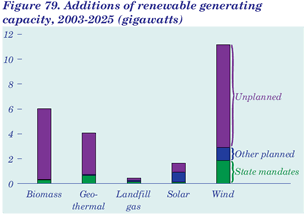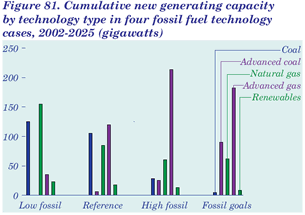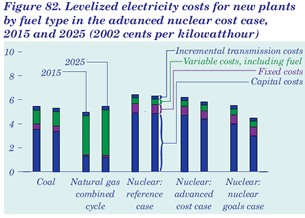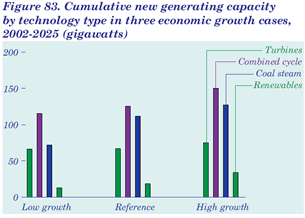|
Annual Energy Outlook 2004 with Projections to 2025 Market Trends - Electricity Index (click to jump links) Electricity Use Is Expected To Grow More Slowly Than GDP As generators and combined heat and power plants adjust to the evolving structure of the electricity market, they face slower growth in demand than in the past. Historically, demand for electricity has been related to economic growth; that positive relationship is expected to continue, but the ratio is uncertain.
During the 1960s, electricity demand grew by more than 7 percent per year, nearly twice the rate of economic growth (Figure 67). In the 1970s and 1980s, however, the ratio of electricity demand growth to economic growth declined to 1.5 and 1.0, respectively. Several factors have contributed to this trend, including increased market saturation of electric appliances, improvements in equipment efficiency and utility investments in demand-side management programs, and more stringent equipment efficiency standards. Throughout the forecast, growth in demand for office equipment and personal computers, among other equipment, is offset by slowing growth or reductions in demand for space heating and cooling, refrigeration, water heating, and lighting. Continued saturation of electric appliances, installation of more efficient equipment, and the promulgation of efficiency standards are expected to hold growth in electricity sales to an average of 1.8 percent per year between 2002 and 2025. Changing consumer markets could mitigate the slowing of electricity demand growth seen in the AEO2004 projections. New electric appliances are introduced frequently. If new uses of electricity are more substantial than currently expected, they could offset some or all of the projected efficiency gains. Continued Growth in Electricity Use Is Expected in All Sectors Electricity consumption is projected to increase in all the end-use sectors (Figure 68). The highest growth rate is projected for the commercial sector, at 2.2 percent per year from 2002 to 2025, compared with 1.6 percent for industrial and 1.4 percent for residential electricity demand. Residential demand, which grew faster in the past, varies by season, day, and time of day. Driven by summer peaks, the periodicity of residential demand increases the peak-to-average load ratio for load-serving entities, which must rely on quick-starting turbines or internal combustion units to meet peak demand. From 2000 to 2003, 69 gigawatts of peaking capacity was added—more than the total additions of 59 gigawatts of peaking capacity projected for 2004 to 2025. The projected growth in commercial and industrial electricity demand from 2002 to 2025 (2.2 and 1.6 percent per year, respectively) will require significant additions of baseload generating capacity. From 2000 to 2003, 112 gigawatts of combined-cycle capacity, which is efficient in both baseload and cycling applications, was installed. As a result, only about 12 gigawatts of currently unplanned baseload capacity is projected to be added from 2004 to 2010. After 2010, more rapid growth in baseload capacity is expected. In addition to sectoral sales, combined heat and power plants in 2002 produced 134 billion kilowatthours for their own use in industrial and commercial processes, such as petroleum refining and paper manufacturing. Combined heat and power generation is expected to increase to 210 billion kilowatthours in 2025, as demand for manufactured products increases. Electricity Generating Capacity Recent Surge in Capacity Additions Is Expected To Meet Near-Term Needs From 1960 to 1969, U.S. power suppliers brought 180 gigawatts of new generating capacity on line—an average of 18 gigawatts per year—and over the next 5 years, from 1970 to 1974, the pace doubled to an average of 36 gigawatts per year. Nearly 314 gigawatts of new capacity was brought on between 1970 and 1979, almost 75 percent more than in the previous 10 years. New capacity additions slowed to 172 gigawatts in the 1980s and 84 gigawatts in the 1990s, and by the mid- to late 1990s, many regions of the country needed or were close to needing new capacity in order to meet consumer requirements reliably.
In 2000 and 2001, higher wholesale electricity prices sent strong signals to power plant developers that supplies were tightening, and they embarked on a dramatic building campaign. Although they had not built 20 gigawatts of new capacity in a single year since 1985, they built 27 gigawatts in 2000, 42 gigawatts in 2001 and 72 gigawatts in 2002 and are on pace to build 45 gigawatts in 2003 (Figure 69). More recently, however, developers have reported that they are delaying or canceling planned plants. New additions slowed in 2003, and that trend is expected to continue in the near term. Most of the recent additions are natural-gas-fired. Of the 187 gigawatts added between 2000 and 2003, 175 gigawatts is natural-gas-fired, including 110 gigawatts of efficient combined-cycle capacity and 65 gigawatts of combustion turbine capacity, which is used mainly when demand for electricity is high. Only about 5 gigawatts of new renewable plants—mostly wind—and less than 1 gigawatt of new coal-fired capacity were added over the same period. Retirements and Rising Demand Are Expected To Require New Capacity Although recent capacity additions will meet near-term needs for electricity generation, more capacity will be needed eventually, as electricity use grows and older, inefficient plants are retired. From 2002 to 2025, 356 gigawatts of new generating capacity is expected to be needed (Figure 70), most of it after 2010, when the current excess supply situation has subsided. For example, between 2002 and 2010, only 88 gigawatts of new capacity (57 gigawatts of which is already in development) is projected to be needed— equivalent to approximately 11 gigawatts of capacity annually. Between 2011 and 2025, however, the amount of new capacity needed is projected to grow to 268 gigawatts—an average of 19 gigawatts annually. In addition to meeting the growing demand for electricity, new plants will be built to replace older plants that are expected to be retired. From 2002 to 2025, a total of 62 gigawatts of capacity is expected to be retired, virtually all fossil fired. The largest component of retirements is expected to be older oil- and natural-gas-fired steam plants, as well as smaller amounts of older oil- and natural-gas-fired combustion turbines and coal-fired plants, which are not competitive with newer natural gas combustion turbine or combined-cycle plants. For oil- and natural-gas-fired steam plants, 35 out of 134 gigawatts of existing capacity is expected to be retired. For combustion turbines and coal-fired plants, 15 and 10 gigawatts of capacity are expected to be retired, respectively. Many older oil- and natural-gas-fired steam plants have efficiencies less than 30 percent. In contrast, the efficiencies of new combined-cycle plants are near 50 percent, and they are expected to continue to improve. Early Capacity Additions Use Natural Gas, Coal Plants Are Added Later
With growing demand after 2010, 356 gigawatts of new generating capacity (including end-use combined heat and power) will be needed by 2025, with about half coming on line between 2016 and 2025. Of the new capacity, nearly 62 percent is projected to be natural-gas-fired combined-cycle, combustion turbine, or distributed generation technology (Figure 71). As natural gas prices rise later in the forecast, new coal-fired capacity is projected to become increasingly competitive, accounting for nearly one-third of all the capacity expansion expected over the forecast. Two new coal-fired plants (just over 1 gigawatt of capacity) are already under construction, scheduled for operation by 2006. From 2011 to 2025, 105 gigawatts of new coal-fired capacity is expected to be brought on line—more than one-half of it after 2020. From 2011 on, coal-fired capacity is expected to account for 40 percent of all capacity additions. Coal additions comprise 40 percent of total unplanned additions over the forecast. Most of the coal capacity is expected to be advanced pulverized coal. With higher capital costs and relatively inexpensive fuel, integrated coal gasification additions are limited to 6 gigawatts of commercial penetration. Renewable technologies account for just over 5 percent of expected capacity expansion by 2025—primarily wind and biomass units. Distributed generation, mostly gas-fired microturbines, is expected to add just over 12 gigawatts. Oil-fired steam plants, which have higher fuel costs and lower efficiencies, are not expected to account for any new capacity in the forecast, other than limited industrial combined heat and power applications. Least Expensive Technology Options Are Likely Choices for New Capacity
Technology choices for new generating capacity are made to minimize cost while meeting local and Federal emissions constraints. The choice of technology for capacity additions is based on the least expensive option available (Figure 72) [111]. The reference case assumes a capital recovery period of 20 years. In addition, the cost of capital is based on competitive market rates, to account for the risks of siting new units. The costs (other than fuel) and performance characteristics for new plants are expected to improve over time (Table 21), at rates that depend on the current stage of development for each technology. For the newest technologies, capital costs are initially adjusted upward to reflect the optimism inherent in early estimates of project costs. As project developers gain experience, the costs are assumed to decline. The decline continues at a slower rate as more units are built. The performance (efficiency) of new plants is also assumed to improve, with heat rates for advanced combined cycle and coal gasification units declining to 6,350 and 7,200 Btu per kilowatthour, respectively, by 2010. Electricity Fuel Costs and Prices Natural Gas Fuel Costs Are Expected To Rise, Coal and Nuclear To Decline Electricity production costs are a function of the costs for fuel, operations and maintenance, and capital. Fuel costs make up most of the operating costs for fossil-fired units. Falling coal prices have reduced the fuel share of operating costs for coal-fired plants—to about 74 percent in 2001—whereas volatile prices and rapidly increasing usage rates have raised the fuel share for natural-gas-fired combined-cycle plants, to 90 percent in 2001. For nuclear units, fuel costs typically are a much smaller portion of total production costs. Nonfuel operations and maintenance costs are a larger component of the operating costs for nuclear power units than for plants that use fossil fuels. The impact of higher natural gas prices in the projections is offset by increased generation from coal-fired and nuclear power plants and by higher generation efficiencies as new capacity is installed. After recent price spikes, natural gas prices to electricity suppliers are projected to rise by 1.2 percent per year in the forecast, from $3.77 per million Btu in 2002 to $4.92 in 2025 (Figure 73). Sufficient supplies of uranium and fuel processing services are expected to keep nuclear fuel costs around $0.40 per million Btu (roughly 4 mills per kilowatthour) through 2025. Delivered petroleum prices to utilities are expected to increase by 0.5 percent per year from 2002 to 2025, leading to a slight decrease in oil-fired generation. Despite increasing fuel costs, the market share of total generation met by natural gas is projected to increase from 18 percent in 2002 to 23 percent in 2025 due to the greater efficiency of natural gas capacity. Average Electricity Prices Decline From 2001 Highs, Then Gradually Rise Average U.S. electricity prices, in real 2002 dollars, are expected to decline by 8 percent, from 7.2 cents per kilowatthour in 2002 to 6.6 cents in 2008 (Figure 74), and to remain relatively stable until 2011. From 2011 they are projected to increase gradually, by 0.3 percent per year, to 6.9 cents per kilowatthour in 2025, generally following the trend of the generation component of electricity price, which currently makes up 64 percent of electricity prices. The distribution component, accounting for about 28 percent of the total electricity price, is expected to decline at an average annual rate of 0.7 percent as the cost of the distribution infrastructure is spread out over a growing amount of total electricity sales. Transmission prices are expected to increase at an average annual rate of 0.9 percent because of the increased investment needed to meet the projected growth in electricity demand. Delivered electricity prices for residential, commercial, and industrial customers are projected to fall by 5, 10, and 9 percent, respectively, from 2002 to 2013 and then to regain about half of those losses by 2025. In 2003, 17 States and the District of Columbia had competitive retail electricity markets in operation. Four States—Montana, Nevada, New Mexico, and Oklahoma—have delayed opening competitive retail markets. Arkansas repealed its restructuring legislation in February 2003. California’s competitive retail market remains suspended, and some of its large power contracts have been renegotiated. States have cited a lack of operational wholesale markets and inadequate generation and transmission capacity as reasons for delaying retail competition. Electricity from Nuclear Power Natural Gas Is Expected To Surpass Nuclear Power in Electricity Supply As they have since early in this century, coal-fired power plants are expected to remain the key source of electricity through 2025 (Figure 75). In 2002, coal accounted for 1,928 billion kilowatthours or 50 percent of total generation, including output at combined heat and power plants. Coal-fired generation is projected to maintain a 50-percent share through 2010 and grow to 52 percent in 2025 at 3,029 billion kilowatthours. The huge investment in existing coal-fired plants and high utilization rates at those plants are expected to keep coal in its dominant position. By 2025, it is projected that 25 gigawatts of coal-fired capacity will be retrofitted with scrubbers to comply with environmental regulations. A total of 112 gigawatts of new coal-fired capacity is projected to be added through 2025, primarily after 2015, when higher natural gas prices lead to the increasing share for coal-fired generation. As a result of improvements in performance and ongoing expansions of existing capacity, electricity generation from nuclear power plants is expected to increase modestly through 2017 before leveling off through the remainder of the forecast period. In percentage terms, natural-gas-fired generation shows the largest increase in the forecast, from 18 percent of total electricity supply in 2002 to 21 percent in 2010 and 23 percent in 2025. As a result, by 2007, natural gas is expected to overtake nuclear power as the Nation’s second-largest source of electricity. Generation from oil-fired plants is projected to remain fairly small throughout the forecast. Nuclear Power Plant Capacity Factors Are Expected To Increase Modestly The United States currently has 104 operable nuclear units, which provided 20 percent of total electricity generation in 2002. The performance of U.S. nuclear units has improved in recent years, to a national average capacity factor of 90 percent in 2002 (Figure 76). It is assumed that these performance improvements will be maintained as plants age, leading to a weighted average capacity factor of 91 percent after 2010. In the reference case, no nuclear units are projected to be retired from 2002 to 2025. Nuclear capacity grows slightly due to assumed increases at existing units. The U.S. Nuclear Regulatory Commission (NRC) approved 18 applications for power uprates in 2002, and another 9 were approved or pending in 2003. The reference case assumes that all the uprates will be carried out, as well as others expected by the NRC over the next 15 years, leading to an increase of 3.9 gigawatts in total nuclear capacity by 2025. No new nuclear units are expected to become operable between 2002 and 2025, because natural gas and coal-fired units are projected to be more economical. Nuclear units would be retired if their operation were no longer economical relative to the cost of building replacement capacity. By 2025, the majority of nuclear units will be beyond their original licensed lifetimes. As of October 2003, license renewals for 16 nuclear units had been approved by the NRC, and 16 other applications were being reviewed. As many as 26 additional applicants have announced intentions to pursue license renewals over the next 3 years, indicating a strong interest in maintaining the existing stock of nuclear plants. Electricity from Renewable Sources Increases in Nonhydropower Renewable Generation Are Expected In the AEO2004 reference case, despite improvements and incentives, grid-connected generators that use renewable fuels (including combined heat and power and other end-use generators) are projected to remain minor contributors to U.S. electricity supply, increasing from 343 billion kilowatthours of generation in 2002 (9.0 percent of total generation) to 525 billion kilowatthours in 2025 (9.1 percent of generation). Low precipitation in 2002 held hydroelectric generation to 260 billion kilowatthours. In the reference case, conventional hydropower provides 309 billion kilowatthours annually, amounting to 5.3 percent of total generation in 2025 (Figure 77). Nonhydroelectric renewables account for 6.6 percent of projected additions to U.S. generating capacity from 2002 to 2025 and 6.8 percent of the projected increase in generation. Generation from nonhydropower renewables is projected to increase from 83 billion kilowatthours in 2002 (2.2 percent of generation) to 216 billion in 2025 (3.7 percent of generation). Biomass is the largest source of nonhydroelectric renewable generation in the forecast, including combined heat and power systems and biomass co-firing in coal-fired power plants. Electricity output from biomass combustion is projected to increase from 37 billion kilowatthours in 2002 (1.0 percent of generation) to 81 billion kilowatthours in 2025 (1.3 percent of generation). Most of the increase (54 percent) is expected from combined heat and power and the rest primarily from dedicated biomass plants. Nevertheless, generation using biomass co-fired in coal-burning plants reaches as much as 16 percent of biomass generation in 2016 before declining to 6 percent in 2025. Biomass, Wind, and Geothermal Lead Growth in Renewables AEO2004 projects significant increases in electricity generation from both wind and geothermal power (Figure 78). From 4.8 gigawatts in 2002, total wind capacity is projected to increase to 8.0 gigawatts in 2010 and 16.0 gigawatts in 2025. Generation from wind capacity is projected to increase from about 11 billion kilowatthours in 2002 (0.3 percent of generation) to 53 billion in 2025 (0.9 percent). Nevertheless, the mid-term prospects for wind power are uncertain, depending on future cost and performance, transmission availability, extension of the Federal production tax credit after 2003, other incentives, energy security, public interest, and environmental preferences. Geothermal output, all located in the West, is projected to increase from 13 billion kilowatthours in 2002 (0.3 percent of generation) to 47 billion in 2025 (0.8 percent). Generation from municipal solid waste and landfill gas is projected to increase by nearly 9 billion kilowatthours, to about 31 billion kilowatthours (0.5 percent of generation) in 2025. No new waste-burning capacity is expected to be added in the forecast. Solar technologies are not expected to make significant contributions to U.S. grid-connected electricity supply through 2025. In total, grid-connected photovoltaic and solar thermal generators together provided about 0.6 billion kilowatthours of electricity generation in 2002 (0.02 percent of generation), and they are projected to supply nearly 5 billion kilowatthours (0.08 percent) in 2025 [112]. State Mandates Call for More Generation From Renewable Energy AEO2004 projects additions of 23 gigawatts of new nonhydroelectric renewable generating capacity from 2002 to 2025, including 18 gigawatts in the electric power sector, 4 gigawatts in combined heat and power, and 1 gigawatt in small-scale end-use applications. In the electric power sector, 3.1 gigawatts of new capacity is projected as a result of State mandates (wind power 1.9 gigawatts, geothermal 0.7 gigawatts, biomass 0.3 gigawatts, landfill gas 0.2 gigawatts, and solar photovoltaic plus thermal, 0.1 gigawatts) and the rest from commercial projects (Figure 79). The commercial projects include 0.08 gigawatts of central-station solar thermal and 0.3 gigawatts of grid-connected central-station photovoltaic capacity that is assumed to be built for testing, demonstration, environmental, and other reasons. In the reference case, a number of States with mandates and renewable portfolio standards are projected to add significant amounts of renewable capacity after 2002. They include California (1,210 megawatts), Minnesota (921 megawatts), Nevada (470 megawatts), Pennsylvania (95 megawatts, built in West Virginia), Texas (270 megawatts), New Mexico (205 megawatts), and Massachusetts (175 megawatts). Other States with smaller requirements include Arizona, Connecticut, Illinois, and Wisconsin. Most identified new capacity is expected to be constructed in the near term—43 percent by 2003 and two-thirds by 2006. Because the Federal production tax credit for wind plants is scheduled to expire on December 31, 2003, 1,664 megawatts (58 percent) of currently planned new wind capacity is projected to be built before the end of 2003. With Lower Cost Assumptions, Wind and Geothermal Capacity Increase The low renewables case assumes that the cost and performance characteristics for key nonhydropower renewable energy technologies remain fixed at current levels; the high renewables case assumes cost reductions of 10 percent on a site-specific basis [113]; the DOE goals case assumes lower capital costs, higher capacity factors, and lower operating costs, based on the renewable energy goals of the U.S. Department of Energy [114]. In each case, assumptions for nonrenewable technologies are the same as in the reference case. In the low renewables case, construction of new renewable capacity is considerably lower than projected in the reference case (Figure 80). In the high renewables case, additions of geothermal, biomass, and wind capacity are substantially higher than projected in the reference case, with most of the incremental capacity added between 2010 and 2025; however, nonhydropower renewables remain relatively small contributors to total generation, at 139 billion kilowatthours (3.1 percent of the total) in 2010 and 334 billion kilowatthours (5.7 percent) in 2025. In the DOE goals case, still more wind and geothermal generating capacity is projected to be added. Geothermal electricity generation in 2010 is lower in the DOE goals case than in the reference case, but in 2025 it is almost double the reference case projection, at 90 billion kilowatthours, or approximately 1.6 percent of total generation. Generation from wind power in 2010 is 29 percent higher in the DOE goals case, at 31 billion kilowatthours, than in the reference case, and in 2025 it is more than six times higher, at 331 billion kilowatthours or 5.7 percent of total generation. Gas-Fired Technologies Lead New Additions of Generating Capacity The AEO2004 reference case uses the cost and performance characteristics of generating technologies to select the mix and amounts of new generating capacity for each year in the forecast. Values for technology characteristics are determined in consultation with industry and government specialists, but uncertainty surrounds the assumptions for new technologies. In the high fossil fuel case, capital costs, heat rates, and operating costs for advanced fossil-fired generating technologies (integrated coal gasification combined cycle, advanced combined cycle, and advanced combustion turbine) reflect a 10-percent reduction from reference case levels in 2025. The fossil goals case assumes improved costs and efficiencies as a result of accelerated research and development, as specified by the Department of Energy’s Fossil Energy program goals. The low fossil fuel case assumes no change in capital costs and heat rates for advanced technologies from their 2004 levels.
Natural gas technologies make up the largest share of new capacity additions in all cases, but the mix of current and advanced technologies varies (Figure 81). In the high fossil and fossil goals cases, advanced technologies are used for 78 percent (213 gigawatts) and 75 percent (182 gigawatts) of projected gas-fired capacity additions, compared with 19 percent (35 gigawatts) in the low fossil case. The coal share of total capacity additions varies from 16 percent to 37 percent. In the low fossil case, only a negligible amount of advanced coal-fired generating capacity is added. In the high cases, advanced coal technologies are more competitive, making up almost half of all coal-fired capacity additions in the high fossil fuel case and 95 percent in the fossil goals case. Sensitivity Case Looks at Possible Reductions in Nuclear Power Costs The AEO2004 reference case assumptions for the cost and performance characteristics of new technologies are based on cost estimates by government and industry analysts, allowing for uncertainties about new, unproven designs. Two advanced nuclear cost cases analyze the sensitivity of the projections to yet lower costs for new nuclear power plants. The advanced nuclear cost case assumes capital and operating costs 10 percent below the reference case in 2025, reflecting a 19-percent reduction in overnight capital costs from 2005 to 2025. The nuclear goals case assumes reductions relative to the reference case of 18 percent initially and 38 percent in 2025. These costs are consistent with estimates from British Nuclear Fuels Limited for the manufacture of its advanced pressurized-water reactor (AP1000). Cost and performance characteristics for all other technologies are assumed to be the same as those in the reference case.
Projected nuclear generating costs in the advanced nuclear cost case are not competitive with the generating costs projected for new coal- and natural-gas-fired units, but toward the end of the projection period the costs assumed in the nuclear goals case are competitive (Figure 82). No nuclear capacity is added when costs are reduced by only 10 percent relative to the reference case, but with the greater reductions assumed in the nuclear goals case, 26 gigawatts of new nuclear capacity is added by 2025. The additional nuclear capacity displaces primarily coal and a smaller amount of natural gas capacity. The projections in Figure 82 are average generating costs, assuming generation at the maximum capacity factor for each technology; the costs and relative competitiveness of the technologies could vary across regions. Rapid Economic Growth Would Boost New Natural Gas and Coal Capacity The projected annual average growth rate for GDP from 2002 to 2025 ranges from 3.5 percent in the high economic growth case to 2.4 percent in the low economic growth case. The difference leads to a 5-percent change in projected electricity demand in 2010 and a 14-percent change in 2025, with a corresponding difference of 138 gigawatts in the amount of new capacity projected to be built from 2002 to 2025 in the high and low economic growth cases. More than one-half of the new capacity projected to be needed in the high economic growth case beyond that added in the reference case is expected to consist of new natural-gas-fired plants. The stronger demand growth assumed in the high growth case is also projected to stimulate additions of coal-fired and renewable plants, accounting for 23 and 24 percent, respectively, of the increase in projected capacity additions in the high economic growth case over those projected in the reference case (Figure 83). In the low economic growth case, total capacity additions are reduced by 65 gigawatts, and 61 percent of that projected reduction is in coal-fired capacity additions. Average electricity prices in 2025 are 6 percent higher in the high economic growth case than in the reference case, due to higher natural gas prices and the costs of building additional generating capacity. Electricity prices in 2025 in the low economic growth case are projected to be 5 percent lower than in the reference case. In the high economic growth case, a 4-percent increase in consumption of fossil fuels results in a 4-percent increase in carbon dioxide emissions from electricity generators in 2025. High Demand Increases Capacity Needs, Particularly for Coal Electricity consumption grows in the forecast, but the projected rate of increase is less than historical rates because of assumptions made about improvements in end-use efficiency, demand-side management programs, and population and economic growth. Different assumptions result in substantial changes in the projections. In a high demand case, electricity demand is assumed to grow by 2.5 percent per year from 2002 to 2025, as compared with annual growth of 2.2 percent per year from 1990 to 1999. In the reference case, electricity demand is projected to grow by 1.8 percent per year. As a result, electricity demand is 6 percent higher in the high demand case than in the reference case in 2010 and 18 percent higher in 2025. In the high demand case, 41 gigawatts more generating capacity is projected to be built from 2002 to 2010 than in the reference case. The difference grows to 206 gigawatts in 2025 (Figure 84). The shares of coal- and natural-gas-fired capacity additions in the electric power sector (including combustion turbine, combined cycle, distributed generation, and fuel cell) are projected to be 37 percent and 58 percent, respectively, in the high demand case and 33 percent and 61 percent in the reference case. Increases in fossil fuel consumption of 6 percent in 2010 and 18 percent in 2025 lead to a higher level of carbon emissions from electricity generators (5 percent higher in 2010 and 18 percent higher in 2025). More rapid growth in electricity demand also leads to higher projected prices for electricity in 2025, averaging 7.1 cents per kilowatthour in the high demand case, compared with 6.9 cents in the reference case. Higher projected fuel prices, especially for natural gas, are the primary reason for the higher electricity prices.
Released: January 2004 |
||||||||||||||||||||||||||||||||||||||||||||||||||||||||||||||||||








